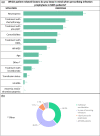Management of infection prophylaxis in Dutch patients with myelodysplastic syndromes, a web-based case vignette questionnaire: The MINDSET study
- PMID: 35753043
- PMCID: PMC9544536
- DOI: 10.1111/ejh.13820
Management of infection prophylaxis in Dutch patients with myelodysplastic syndromes, a web-based case vignette questionnaire: The MINDSET study
Abstract
Objectives: Infections are a major cause of morbidity and mortality in patients with myelodysplastic syndromes (MDS). The objective of the MINDSET study was to evaluate haematologists' management of infection prevention in MDS patients using a case vignette study and to assess the availability of guidelines.
Methods: We conducted a web-based, nationwide survey amongst haematologists in the Netherlands between September and December 2021. The survey included a set of case vignettes. In addition, the availability of protocols was evaluated.
Results: Sixty responses were obtained (23.6%). These responses were well distributed across hospital types as well as level of experience. No protocols regarding infection prophylaxis specifically for MDS patients were received. In the case vignette of a 75-year-old MDS patient, respondents would primarily prescribe infection prophylaxis in case of recurrent infections (96.7%) and neutropenia (75.0% for absolute neutrophil count [ANC] < 0.2 × 109 /L and 53.3% for ANC < 0.5 × 109 /L), especially in combination with hypomethylating agents (80.0%), lenalidomide (66.7%) or chemotherapy (51.7%). Respondents would predominantly choose antibacterial agents (85.0%), followed by antifungal agents (71.7%).
Conclusions: This study showed diverse reasons and considerations of haematologists regarding whether to prescribe infection prophylaxis in MDS patients. Given the seriousness of infections in MDS patients, patient-tailored recommendations might be valuable in clinical decision-making.
Keywords: anti-infective agent; infections; myelodysplastic syndromes; prophylaxis; survey.
© 2022 The Authors. European Journal of Haematology published by John Wiley & Sons Ltd.
Conflict of interest statement
The authors declare no conflict of interest.
Figures



Similar articles
-
Infections and antimicrobial prophylaxis in patients with myelodysplastic syndromes.Semin Hematol. 2024 Dec;61(6):348-357. doi: 10.1053/j.seminhematol.2024.07.004. Epub 2024 Aug 3. Semin Hematol. 2024. PMID: 39198132 Review.
-
The incidence of invasive fungal infections in neutropenic patients with acute leukemia and myelodysplastic syndromes receiving primary antifungal prophylaxis with voriconazole.Am J Hematol. 2013 Apr;88(4):283-8. doi: 10.1002/ajh.23388. Epub 2013 Mar 5. Am J Hematol. 2013. PMID: 23460251
-
Relationship of treatment-related cytopenias and response to lenalidomide in patients with lower-risk myelodysplastic syndromes.J Clin Oncol. 2008 Dec 20;26(36):5943-9. doi: 10.1200/JCO.2007.15.5770. Epub 2008 Nov 17. J Clin Oncol. 2008. PMID: 19018091 Free PMC article. Clinical Trial.
-
Treatment sequence of lenalidomide and hypomethylating agents and the impact on clinical outcomes for patients with myelodysplastic syndromes.Leuk Lymphoma. 2019 Aug;60(8):2050-2055. doi: 10.1080/10428194.2018.1551538. Epub 2019 Jan 14. Leuk Lymphoma. 2019. PMID: 30636526
-
New Approaches to Myelodysplastic Syndrome Treatment.Curr Treat Options Oncol. 2022 May;23(5):668-687. doi: 10.1007/s11864-022-00965-1. Epub 2022 Mar 23. Curr Treat Options Oncol. 2022. PMID: 35320468 Review.
References
-
- Arber DA, Orazi A, Hasserjian R, et al. The 2016 revision to the World Health Organization classification of myeloid neoplasms and acute leukemia. Blood. 2016;127:2391‐2405. - PubMed
-
- Tefferi A, Vardiman JW. Myelodysplastic syndromes. N Engl J Med. 2009;361:1872‐1885. - PubMed
-
- Rollison DE, Howlader N, Smith MT, et al. Epidemiology of myelodysplastic syndromes and chronic myeloproliferative disorders in the United States, 2001‐2004, using data from the NAACCR and SEER programs. Blood. 2008;112:45‐52. - PubMed
-
- Moreno Berggren D, Folkvaljon Y, Engvall M, et al. Prognostic scoring systems for myelodysplastic syndromes (MDS) in a population‐based setting: a report from the Swedish MDS register. Br J Haematol. 2018;181:614‐627. - PubMed
-
- Dinmohamed AG, Visser O, van Norden Y, et al. Trends in incidence, initial treatment and survival of myelodysplastic syndromes: a population‐based study of 5144 patients diagnosed in The Netherlands from 2001 to 2010. Eur J Cancer. 2014;50:1004‐1012. - PubMed
MeSH terms
Substances
LinkOut - more resources
Full Text Sources
Medical
Research Materials
Miscellaneous

